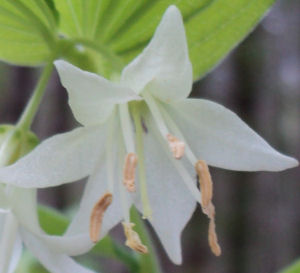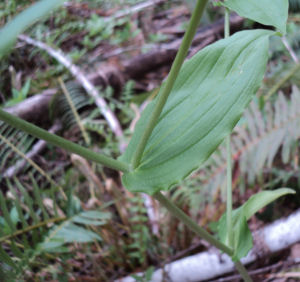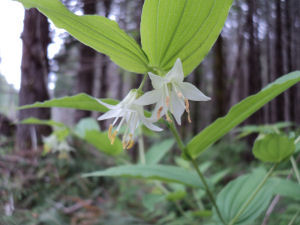PROSARTES - Fairybells
Family: Liliaceae - Lily
"Rhizome slender, creeping to ± erect. Stem: erect, branched, scaly below, leafy above, hairs 0 or generally sharp-branched, generally not glandular, some or all falling in age. Leaf: alternate, sessile to ± clasping, (ob)ovate to elliptic, acute to acuminate, base ± oblique, cordate to acute, main veins >=3, converging. Inflorescence: umbel-like, terminal; flowers 1–7, pendent. Flower: perianth parts 6, in 2 whorls, petal-like, free, white to ± green, bases green, generally convex; stamens 6, free, anthers generally < filaments, generally oblong, generally glabrous; ovary superior, chambers (1)3, style slender, stigma entire or 3-lobed. Fruit: berry, orange to red. Seed: white to pale yellow."
"6 species: temperate North America. (Greek: to append, from pendulous ovules of type sp.) [Mesler et al. 2010 Madroño 52:129–135]" [Jepson]
Local Species;
- Prosartes hookeri - Hooker's fairybells [E-flora][TSFTK]
- Prosartes smithii - Smith's fairybells [E-flora][TSFTK]
- Prosartes trachycarpa - Rough-fruited fairybells [E-flora]
Habitat/Range
P. hookeri; "Moist to mesic forests in the lowland and montane zones; common in BC south of 55degreeN; E to AB and W MT, ID and NW OR."[IFBC-E-flora]
P. smithii; "Moist forests and streambanks in the lowland zone; rare on S Vancouver Island; S to CA." [IFBC-E-flora]
P.trachycarpa; "Moist to dry forests, forest edges, thickets and clearings in the steppe and montane zones; common in BC east of the Coast-Cascade Mountains and S of 56degreeN; E to MB and S to SD, NM, AZ and OR." [IFBC-E-flora]

| 
| 
|
(above photos) Prosartes hookeri
|
Species Mentioned;
- Fairybells - Disporum species (The fifteen Disporum species grow in temperate North America and eastern Asia. including Fairybell (D. hookeri), Rough-fruited fairybell (D. trachycarpum) and
Fairy lantern (D. smithii))[Derig WBOTW]
Hazards
Disporum hooken var. oreganum (S. Wats.); Plant considered poisonous. ·[NAEth Moerman]Disporum Sp; The Klallam considered them poisonous [Derig WBOTW]
Uses
Most Native Americans did not eat fairybells, though several groups used them for medicine. [Derig WBOTW]
Edible Uses
- Fruit
- The juicy, modestly sweet berries of fairybells are worth nibbling on walks through the woods. [Derig WBOTW]
- P. trachycarpum; Fruit - raw[105, 161, 177, 257]. A sweet flavour[212]. The fruit is up to 10mm in diameter and is leathery rather than pulpy[235]. [PFAF]
- Disporum trachycarpum, D. oreganum - Fairybells; The small flowers have been eaten, but are really too small and pretty to use. The sweet juicy orange berries were a favorite of the Blackfoot people. If they are sufficiently abundant. they can be used in pies and preserves. The berries of most related species are unpleasant, or even mildly toxic. [Tozer UWP]
- Disporum hookeri; Fruit occasionally used for food, but not considered important. (187:121)[NAEth Moerman]
Other Uses
- Love Potion: "The Makah used both fairy bell and fairy lantern as a love potion." [Derig WBOTW]
Medicinal Uses
- Fruit
- Disporum hookeri; Kidney Aid -Fruit used for the kidneys. (21 :28) [NAEth Moerman]
- Seeds
- P. trachycarpum; The seed has been used to clear foreign objects from the eye. A fresh seed was inserted and the eye closed then rubbed until the seed was watered out with the foreign object clinging to it[257]. The seeds were also placed in the eye overnight and an infusion of the bark used as an eyewash to treat snow-blindness[257]. [PFAF]
- Leaves
- P. trachycarpum; An infusion of the leaves has been used as a wash for wounds whilst a poultice of the dampened bruised leaves has been applied to bleeding wounds[257]. [PFAF]
- Disporum Sp.; An infusion of stems or leaves was used to treat wounds and sore eyes. [Derig WBOTW]
- Root
- Disporum Sp.; Analgesic - Compound decoction of roots taken for internal pains.[NAEth Moerman]
Cultivation
"Fairybells grow well in moist, woodland gardens and shady borders in USDA zones 6 to 9. The delicate, drooping flowers are not flamboyant, but the handsome leaves fill in around hosta, ferns, and spring' blooming bulbs. The plants spread slowly, forming colonies." [Derig WBOTW]
P. trachycarpum; Best grown in partial shade in a moist peaty or woodland soil[1, 175]. A very hardy plant, tolerating temperatures down to about -20°c[187]. Plants spread well by means of creeping rhizomes when they are grown in a leafy soil[187]. This species is closely related to D. smithii[233].[PFAF]
Wildlife
Disporum hooken var. oreganum (S. Wats.); Berries eaten by wolves. [NAEth Moerman]
Disporum smithii (Hook.); Piper; Berries eaten by squirrels. [NAEth Moerman]
Propagation
P. trachycarpum; "Seed - best sown in a cold frame as soon as it is ripe[175]. Use a lime-free compost and keep it moist[175]. Stored seed requires 6 weeks cold stratification and should be sown as early in the year as possible[175]. Germination usually takes place within 3 - 6 months or more at 15°c[175]. When they are large enough to handle, prick the seedlings out into individual pots and grow them on in the greenhouse for at least their first winter. Plant them out into their permanent positions in late spring or early summer, after the last expected frosts. Division in spring[200]." [PFAF]
Syn: Disporum [E-flora]
References
- [E-flora]
- Prosartes hookeri, http://linnet.geog.ubc.ca/Atlas/Atlas.aspx?sciname=Prosartes%20hookeri&redblue=Both&lifeform=7, Accessed July 5, 2018
- Prosartes smithii, http://linnet.geog.ubc.ca/Atlas/Atlas.aspx?sciname=Prosartes%20smithii&redblue=Both&lifeform=7, Accessed July 5, 2018
- Prosartes trachycarpa, http://linnet.geog.ubc.ca/Atlas/Atlas.aspx?sciname=Prosartes%20trachycarpa&redblue=Both&lifeform=7, Accessed July 5, 2018
- [Jepson] 2013. Prosartes, Michael R. Mesler & Robin Bencie, in Jepson Flora Project (eds.) Jepson eFlora, http://ucjeps.berkeley.edu/cgi-bin/get_IJM.pl?tid=69118, accessed on Jan 30 2015
- [PFAF] Accessed March 30, 2015
Journals of Interest
- Williams, Christine A., et al. "Correlations between leaf flavonoids, taxonomy and plant geography in the genus Disporum." Phytochemistry 34.1 (1993): 197-203.
https://doi.org/10.1016/S0031-9422(00)90805-7
- Jeon, Na Ra, et al. "Phytoestrogenic activity of ethanol extract from Korean wild vegetable Disporum uniflorum." Food Science and Biotechnology 19.6 (2010): 1543-1550. DOI: 10.1007/s10068-010-0219-3
Page last modified on Saturday, May 25, 2019 0:45 AM